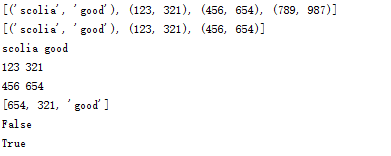Python hmac模块使用实例解析
这篇文章主要介绍了Python hmac模块使用实例解析,文中通过示例代码介绍的非常详细,对大家的学习或者工作具有一定的参考学习价值,需要的朋友可以参考下
hmac模块的作用:
用于验证信息的完整性。
1、hmac消息签名(默认使用MD5加算法)
hmac_md5.py
#!/usr/bin/env python
# -*- coding: utf-8 -*-
import hmac
#默认使用是md5算法
digest_maker = hmac.new('secret-shared-key'.encode('utf-8'))
with open('content.txt', 'rb') as f:
while True:
block = f.read(1024)
if not block:
break
digest_maker.update(block)
digest = digest_maker.hexdigest()
print(digest)
content.txt
Lorem ipsum dolor sit amet, consectetuer adipiscing elit. Donec egestas, enim et consectetuer ullamcorper, lectus ligula rutrum leo, a elementum elit tortor eu quam. Duis tincidunt nisi ut ante. Nulla facilisi. Sed tristique eros eu libero. Pellentesque vel arcu. Vivamus purus orci, iaculis ac, suscipit sit amet, pulvinar eu, lacus. Praesent placerat tortor sed nisl. Nunc blandit diam egestas dui. Pellentesque habitant morbi tristique senectus et netus et malesuada fames ac turpis egestas. Aliquam viverra fringilla leo. Nulla feugiat augue eleifend nulla. Vivamus mauris. Vivamus sed mauris in nibh placerat egestas. Suspendisse potenti. Mauris massa. Ut eget velit auctor tortor blandit sollicitudin. Suspendisse imperdiet justo.
运行效果
[root@ mnt]# python3 hmac_md5.py 79cbf5942e8f67be558bc28610c02117
2、hmac消息签名摘要(使用SHA1加算法)
hmac_sha1.py
#!/usr/bin/env python
# -*- coding: utf-8 -*-
import hmac
digest_maker = hmac.new('secret-shared-key'.encode('utf-8'), b'', digestmod='sha1')
# hmac.new(key,msg,digestmod)
# key:加盐的key,
# msg:加密的内容,
# digestmod:加密的方式
with open('hmac_sha1.py', 'rb') as f:
while True:
block = f.read(1024)
if not block:
break
digest_maker.update(block)
digest = digest_maker.hexdigest()
print(digest)
运行效果
[root@ mnt]# python3 hmac_sha1.py e5c012eac5fa76a274f77ee678e6cc98cad8fff9
3、hmac二进制消息签名摘要(使用SHA1加算法)
hmac_base64.py
#!/usr/bin/env python
# -*- coding: utf-8 -*-
import hmac
import base64
import hashlib
with open('test.py', 'rb') as f:
body = f.read()
# 默认使用是md5算法
digest_maker = hmac.new('secret-shared-key'.encode('utf-8'), body, hashlib.sha1)
# hmac.new(key,msg,digestmod)
# key:加盐的key,
# msg:加密的内容,
# digestmod:加密的方式
digest = digest_maker.digest() # 默认内容是字节类型,所以需要base64
print(base64.encodebytes(digest)) #注意base64结果是以\n结束,所以Http头部或其它传输时,需要去除\n
运行效果
[root@ mnt]# python3 hmac_base64.py b'Y9a4OMRqU4DB6Ks/hGfru+MNXAw=\n'
4、hmac摘要数据比较示例
hmac_pickle.py
#!/usr/bin/env python
# -*- coding: utf-8 -*-
import hashlib
import hmac
import io
import pickle
def make_digest(message):
"返消息摘要,加密码后的结果"
hash = hmac.new(
'secret-shared-key'.encode('utf-8'),
message,
hashlib.sha1
)
return hash.hexdigest().encode('utf-8')
class SimpleObject(object):
def __init__(self, name):
self.name = name
def __str__(self):
return self.name
# 输出缓冲区
out_s = io.BytesIO()
o = SimpleObject('digest matches')
pickle_data = pickle.dumps(o) # 序列化
digest = make_digest(pickle_data) # 使用sha1加密算法
header = b'%s %d\n' % (digest, len(pickle_data))
print('提示:{}'.format(header))
out_s.write(header) # 将消息头写入缓冲区
out_s.write(pickle_data) # 将序列化内容写入缓冲区
o = SimpleObject('digest does not matches')
pickle_data = pickle.dumps(o)
digest = make_digest(b'not the pickled data at all')
header = b'%s %d\n' % (digest, len(pickle_data))
print('提示:{}'.format(header))
out_s.write(header) # 将消息头写入缓冲区
out_s.write(pickle_data) # 将序列化内容写入缓冲区
out_s.flush() # 刷新缓冲区
# 输入缓冲区
in_s = io.BytesIO(out_s.getvalue())
while True:
first_line = in_s.readline()
if not first_line:
break
incoming_digest, incoming_length = first_line.split(b' ')
incoming_length = int(incoming_length.decode('utf-8'))
print('读取到:', incoming_digest, incoming_length)
incoming_pickled_data = in_s.read(incoming_length)
actual_digest = make_digest(incoming_pickled_data) # 实际的摘要
print('实际值:', actual_digest)
if hmac.compare_digest(actual_digest, incoming_digest): # 比较两个摘要是否相等
obj = pickle.loads(incoming_pickled_data)
print('OK:', obj)
else:
print('数据不完整')
运行效果
[root@ mnt]# python3 hmac_pickle.py 提示:b'00e080735a8de379e19fe2aa731c92fc9253a6e2 69\n' 提示:b'1d147690f94ea374f6f8c3767bd5a5f9a8989a53 78\n' 读取到: b'00e080735a8de379e19fe2aa731c92fc9253a6e2' 69 实际值: b'00e080735a8de379e19fe2aa731c92fc9253a6e2' OK: digest matches 读取到: b'1d147690f94ea374f6f8c3767bd5a5f9a8989a53' 78 实际值: b'4dcaad9b05bbb67b571a64defa52e8960a27c45d' 数据不完整
以上就是本文的全部内容,希望对大家的学习有所帮助,也希望大家多多支持【听图阁-专注于Python设计】。
